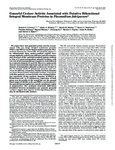Guanylyl cyclase activity associated with putative bifunctional integral membrane proteins in Plasmodium falciparum.
| dc.contributor.author | Carucci, DJ | en |
| dc.contributor.author | Witney, AA | en |
| dc.contributor.author | Muhia, DK | en |
| dc.contributor.author | Warhurst, DC | en |
| dc.contributor.author | Schaap, P | en |
| dc.contributor.author | Meima, M | en |
| dc.contributor.author | Li, JL | en |
| dc.contributor.author | Taylor, MC | en |
| dc.contributor.author | Kelly, JM | en |
| dc.contributor.author | Baker, DA | en |
| dc.date.accessioned | 2017-11-27T19:49:33Z | |
| dc.date.available | 2017-11-27T19:49:33Z | |
| dc.date.issued | 2000-07-21 | en |
| dc.identifier.issn | 0021-9258 | en |
| dc.identifier.uri | http://hdl.handle.net/10026.1/10334 | |
| dc.description.abstract |
We report here that guanylyl cyclase activity is associated with two large integral membrane proteins (PfGCalpha and PfGCbeta) in the human malaria parasite Plasmodium falciparum. Unusually, the proteins appear to be bifunctional; their amino-terminal regions have strong similarity with P-type ATPases, and the sequence and structure of the carboxyl-terminal regions conform to that of G protein-dependent adenylyl cyclases, with two sets of six transmembrane sequences, each followed by a catalytic domain (C1 and C2). However, amino acids that are enzymatically important and present in the C2 domain of mammalian adenylyl cyclases are located in the C1 domain of the P. falciparum proteins and vice versa. In addition, certain key residues in these domains are more characteristic of guanylyl cyclases. Consistent with this, guanylyl cyclase activity was obtained following expression of the catalytic domains of PfGCbeta in Escherichia coli. In P. falciparum, expression of both genes was detectable in the sexual but not the asexual blood stages of the life cycle, and PfGCalpha was localized to the parasite/parasitophorous vacuole membrane region of gametocytes. The profound structural differences identified between mammalian and parasite guanylyl cyclases suggest that aspects of this signaling pathway may be mechanistically distinct. | en |
| dc.format.extent | 22147 - 22156 | en |
| dc.language | eng | en |
| dc.language.iso | eng | en |
| dc.subject | Amino Acid Sequence | en |
| dc.subject | Animals | en |
| dc.subject | Guanylate Cyclase | en |
| dc.subject | Humans | en |
| dc.subject | Membrane Proteins | en |
| dc.subject | Molecular Sequence Data | en |
| dc.subject | Plasmodium falciparum | en |
| dc.subject | Protozoan Proteins | en |
| dc.subject | Sequence Alignment | en |
| dc.title | Guanylyl cyclase activity associated with putative bifunctional integral membrane proteins in Plasmodium falciparum. | en |
| dc.type | Journal Article | |
| plymouth.author-url | https://www.ncbi.nlm.nih.gov/pubmed/10747978 | en |
| plymouth.issue | 29 | en |
| plymouth.volume | 275 | en |
| plymouth.publication-status | Published | en |
| plymouth.journal | J Biol Chem | en |
| dc.identifier.doi | 10.1074/jbc.M001021200 | en |
| plymouth.organisational-group | /Plymouth | |
| plymouth.organisational-group | /Plymouth/REF 2021 Researchers by UoA | |
| plymouth.organisational-group | /Plymouth/REF 2021 Researchers by UoA/UoA01 Clinical Medicine | |
| plymouth.organisational-group | /Plymouth/REF 2021 Researchers by UoA/UoA01 Clinical Medicine/UoA01 Clinical Medicine | |
| dc.publisher.place | United States | en |
| dc.rights.embargoperiod | Not known | en |
| rioxxterms.versionofrecord | 10.1074/jbc.M001021200 | en |
| rioxxterms.licenseref.uri | http://www.rioxx.net/licenses/all-rights-reserved | en |
| rioxxterms.type | Journal Article/Review | en |


